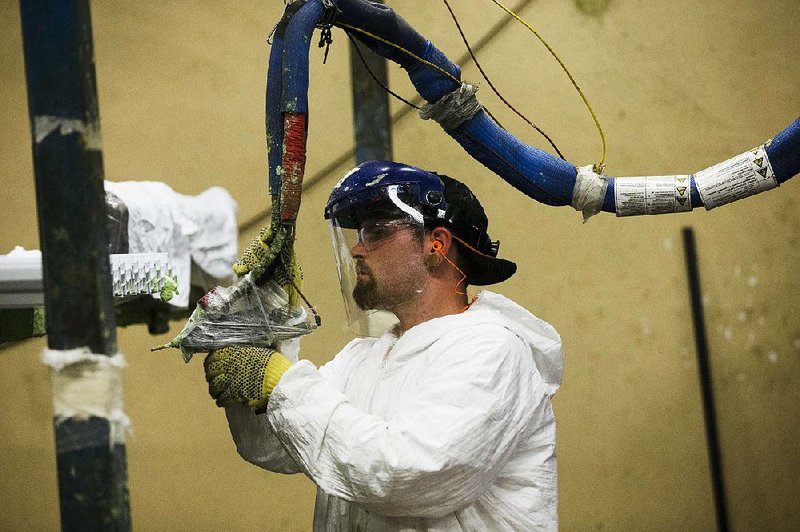WASHINGTON -- Orders to U.S. factories posted a modest gain in July, helped by the biggest rise in motor-vehicle orders in a year and a solid gain in a category that tracks business investment plans.
Factory orders rose 0.4 percent in July, the Commerce Department reported Wednesday. Orders had increased a much larger 2.2 percent in June.
The modest increase in factory orders in July suggests that manufacturing is still grappling with a variety of challenges, from falling energy prices to a stronger dollar, which hurts exports.
But a key category that tracks business investment plans climbed 2.1 percent, posting the strongest gain in 13 months.
For July, orders for motor vehicles surged 4 percent, the largest jump since July 2014.
Orders for durable goods, items expected to last at least three years such as bicycles and battleships, increased 2.2 percent in July, slightly stronger than the 2 percent estimate the government made last week. Orders for nondurable goods such as chemicals and paper fell 1.3 percent in July after a 0.4 percent rise in June.
Orders in the business investment category had fallen in four of the previous five months before June, reflecting the soft patch that manufacturing has faced this year.
U.S. manufacturers must contend with a number of head winds including a sharp slowdown in growth in China; a strong dollar, which makes U.S. products more expensive in export markets; and falling oil prices, which have caused energy companies to cut back on their invest spending.
On Tuesday, the Institute for Supply Management reported that its manufacturing index slid to 51.1 last month from 52.7 in July. It was the second straight drop. Economists had been expecting the index to rebound modestly in August. Anything above 50 signals growth.
Hiring by U.S. firms picked up a bit last month as the private sector added 190,000 net new jobs, payroll firm Automatic Data Processing, or ADP, said Wednesday.
The job growth was an improvement over July's 177,000 figure, which was revised down from the initial report of 185,000. But the August figure was below analysts' expectations of about 210,000 net new private-sector jobs.
Still, the job creation was solid, said Mark Zandi, chief economist at Moody's Analytics, which assists ADP in preparing the report.
"Recent global financial market turmoil has not slowed the U.S. job market, at least not yet," Zandi said. "Job growth remains strong and broad-based, except in the energy industry, which continues to shed jobs."
The construction industry added 17,000 net new jobs in August, up from 15,000 the previous month, ADP said. New hiring by manufacturers rebounded to 7,000 last month from just 1,000 in July.
Economists watch ADP's monthly report to help forecast overall job growth.
The state of the labor market is key as Federal Reserve officials consider when to raise their benchmark short-term interest rate for the first time since 2006.
The Labor Department is expected to report Friday that the U.S. economy -- private and public sectors -- added about 223,000 net new jobs in August and the unemployment rate ticked down to 5.2 percent.
That would be an improvement from 215,000 net new jobs added in July, and the unemployment rate would be a seven-year low.
Fed officials had appeared on track to raise the interest rate at their Sept. 16-17 meeting if job growth continued to be strong.
But the uneasy financial markets in the U.S. and around the world have complicated the calculations of Fed policymakers, who could decide to delay a rate increase even if job growth is solid in August to avoid adding to the turmoil.
Worker productivity increased at an annual rate of 3.3 percent in the April-June quarter, the Labor Department reported Wednesday. That was a rebound from the first quarter when productivity had fallen at a 1.1 percent rate and a sizable upward revision from the government's first estimate of a 1.3 percent growth rate.
Labor costs fell at a 1.4 percent rate in the second quarter, indicating that wages are not rising even as unemployment declines.
Even with the strong gain in the second quarter, productivity over the past year has increased by just 0.7 percent, far below the long-run average of 2.2 percent. Productivity, the amount of output per hour of work, has been sluggish since the recession and economists have been at a loss to explain the reason for this weakness.
"This update does not change the underlying story. Productivity growth remains low," said Patrick Newport, an economist at IHS Global Insight. "Productivity's slow pace has the [economics] profession puzzled."
Information for this article was contributed by Martin Crutsinger of The Associated Press and by Jim Puzzanghera of the Los Angeles Times.
Business on 09/03/2015
